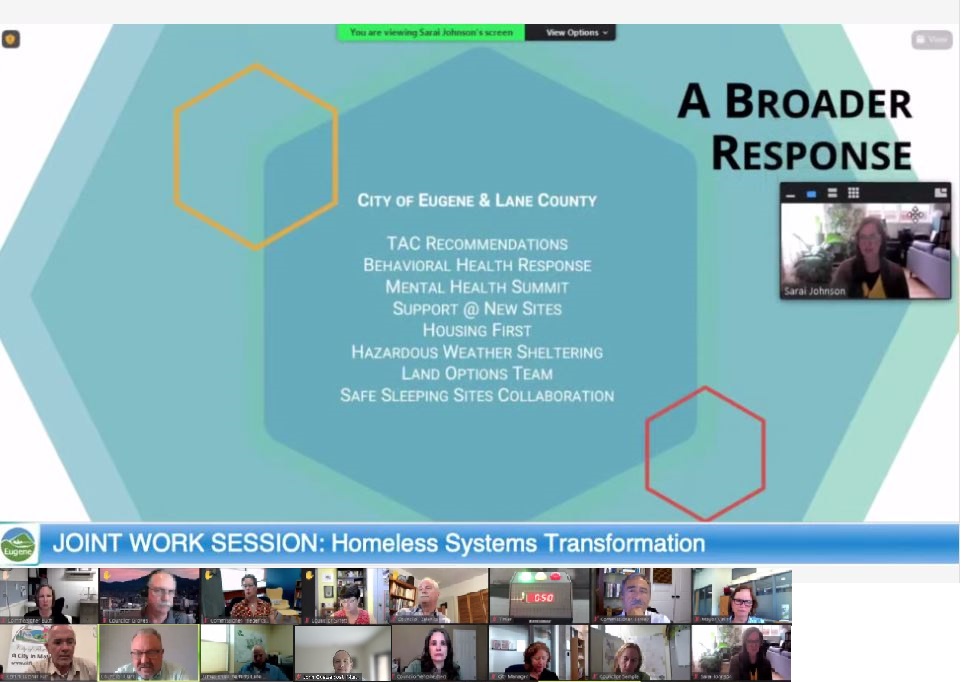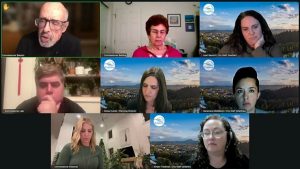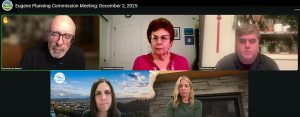City, county electeds hear summer update on street outreach
7 min read
Coordinating street outreach teams from Eugene and Lane County told how they build trust to help people on the streets move into transitional housing.
Eugene and Lane County heard the latest on regional efforts around homelessness. On the county’s street outreach, James Ewell.
[00:00:08] James Ewell: I just wanted to give a brief overview of what street outreach is, its role being to engage unsheltered folks who might not otherwise seek assistance or come to the attention of a homeless service system. And street outreach really ensures that people’s basic needs are being met, in order to support their pathway towards housing stability. So if you think of, Maslow’s hierarchy of needs, to really get to a point where they’re able to be housed, we need to make sure that their imminent basic needs are being met. Street outreach is often the first point of contact for folks entering into homelessness. And so it’s really, I see it as one of the most important interventions within our system.
Core principles of street outreach really should always include meeting people where they’re at. And that is geographically where they’re at and it’s also emotionally and physically. We want to ensure that we’re going to the areas where folks are and that we’re going and approaching them in a way that’s trauma informed, that’s taking into account mental health, substance abuse, those kinds of needs, those things that sometimes when folks are accessing services, it can be a barrier for them to access those services, if their mental health or substance abuse and the behaviors associated with that are are challenging for service providers.
Thank you for supporting
local citizen journalism
Meeting basic needs is a core principle of it, really being respectful and treating everyone with dignity. Building a rapport on street outreach, is probably the key piece to outreach engagement. A lot of the folks that outreach is coming into contact with are not accessing the traditional services. And it’s often because they’re weary of service providers, they’re weary of the government. They want to be off the radar. And so to be able to have those conversations about goals of housing stability, there has to be a relationship built between the outreach worker and the individual, and that can often take time. And it also takes really skilled outreach workers to be able to do that.
[00:01:54] John Q: James said the Coordinated Entry Outreach team is looking to add a third full-time employee. Peter Chavannes spoke about the City’s coordinated outreach.
[00:02:04] Peter Chavannes: From the city’s perspective, coordinated outreach brings together the separate but overlapping responsibilities our jurisdictions have when it comes to homelessness. So of course, one is to support people into more stable situations particularly related to housing, income, health, and community connection. Also, we have a responsibility to maintain public spaces and rights-of-way. And so in FY21, the City utilized one-time dollars to pilot a street outreach team. Learning from this pilot informed the collaborative development of the outreach RFP… Dispatch of this outreach team will be a collaboration with James, the county’s outreach coordinator, as well as City staff. We’re looking to bring on a Camping Response Manager, again, engaging folks where they’re at, trying to understand what their immediate needs are, and help folks think about, ‘Okay, what’s the next step for you in your journey to increase stability.’
[00:03:05] John Q: James said the providers are now holding regular coordination meetings.
[00:03:10] James Ewell: We have started coordinating those outreach efforts, convening of all of the providers in the community that are providing outreach. And it’s really a way for us to coordinate and to focus and make sure that there isn’t a duplication of services happening amongst our providers, and that we’re really ensuring that those folks in the community with the highest vulnerability are the folks that are being prioritized and then referred to available housing options.
[00:03:33] City Councilor Mike Clark: Do you encounter most folks while they are, um, camping in an unsanctioned area?
[00:03:40] James Ewell: We encounter most folks when they’re camping, whether or not it’s an unsanctioned. It, I mean, it’s, I think it’s a mix of both.
[00:03:46] City Councilor Mike Clark: Um, what would you call the percentage of those you encounter camping in an unsanctioned area?
[00:03:52] James Ewell: I’d really have to ballpark,… probably 70 to 80%.
[00:03:56] City Councilor Mike Clark: Well, it sounds like a lot of them, sounds like most of them. Can you tell me, many express weariness to engage with government, and there’s trust issues, there’s reasons for that. What percentage of those you engage express weariness?
[00:04:12] James Ewell: I don’t think it’s most, I mean, when we look at the data, when we look at HMIS for, the folks that are being contacted by Outreach often are in that system already. And so, you know, I think there are folks who say they’re wary of it. They might still be accessing those services, but they’re not going to be as willing to really engage in the in-depth conversations that lead to housing because they don’t want to share that information with someone that they haven’t built a connection with. And so that’s, I think, the piece that Outreach is really able to address—is to build those relationships with them, where they’re at. It creates a different kind of relationship in many ways.
[00:04:48] City Councilor Mike Clark: Last question. On this model, at what point in what year do you think it possible that we end unsanctioned public camping in Eugene?
[00:05:00] Sarai Johnson: I think the broad answer to that is when we have enough places for people to go that are safe for them to sleep and they’re allowed to be, then the enforcement of unsanctioned camping can become a thing. And so right now, what we really have to look at is, what is the opportunity for us to create space for people to go. And this is largely because of the Boise decision and also because of the reality that we simply have underbuilt housing by the tens of thousands for decades.
[00:05:28] City Councilor Mike Clark: The first thing I want to say is that I, I’m absolutely not picking on Sarai. I think you’re awesome, I think you do fantastic work, I’m so glad you’re doing this. But I want to ask the City Manager a question. And the reason for the question is I suspect that others in this meeting, I know I get a question almost every day: ‘When are you going to do something about homelessness?’ Which is one of those questions that kind of has behind it the assumption that we’re not doing much, when clearly we’ve just had a report on the massive amount of things we’re doing. But there’s a disconnect between what the public sees and what they’re experiencing and what we’re doing. That seems pretty clear to me. And for me, a lot of that comes from the fact that there’s a great deal of unsanctioned camps that don’t seem to diminish. So Manager, I am not picking on Sarai. Are you okay with that answer that we’re going to have unsanctioned camps for the foreseeable future and not, it won’t change?
[00:06:28] Sarah Medary: Thank you. Councilor Clark for asking that question. I just want to say there’s been kind of unsanctioned camping in our parks and right of ways since I started working for the city in 1996. So there, there is, I think, uh, always going to be, or for the foreseeable future, probably, people seeking shelter in our parks and right of ways. And I think what you’re getting at is, ‘Okay, but are we going to just allow that at what point are we going to start enforcing?’
What I have observed is that we’ve been in a very thoughtful place as we’ve been in COVID, to try to really balance the needs of the community and this population, as we’ve been following CDC guidelines. And I think we’ve tried to be really upfront about when we are and aren’t going to step in and enforce. And I think when those CDC guidelines change, we’re going to need to have another conversation because the policy direction is actually already pretty well established around what’s legal and what’s not legal, and what’s in the rules and not in the rules. And we can’t just disregard that, right?
Right now we are following the CDC guidelines. We come out of that, I think, um, you’ll see us continue to be very thoughtful, but I don’t think we would be following current policy if we just allowed unsanctioned camping forever. So it’s a tough question. And it’s also hard to answer well, but I think we’ve got more discussions ahead of us.



